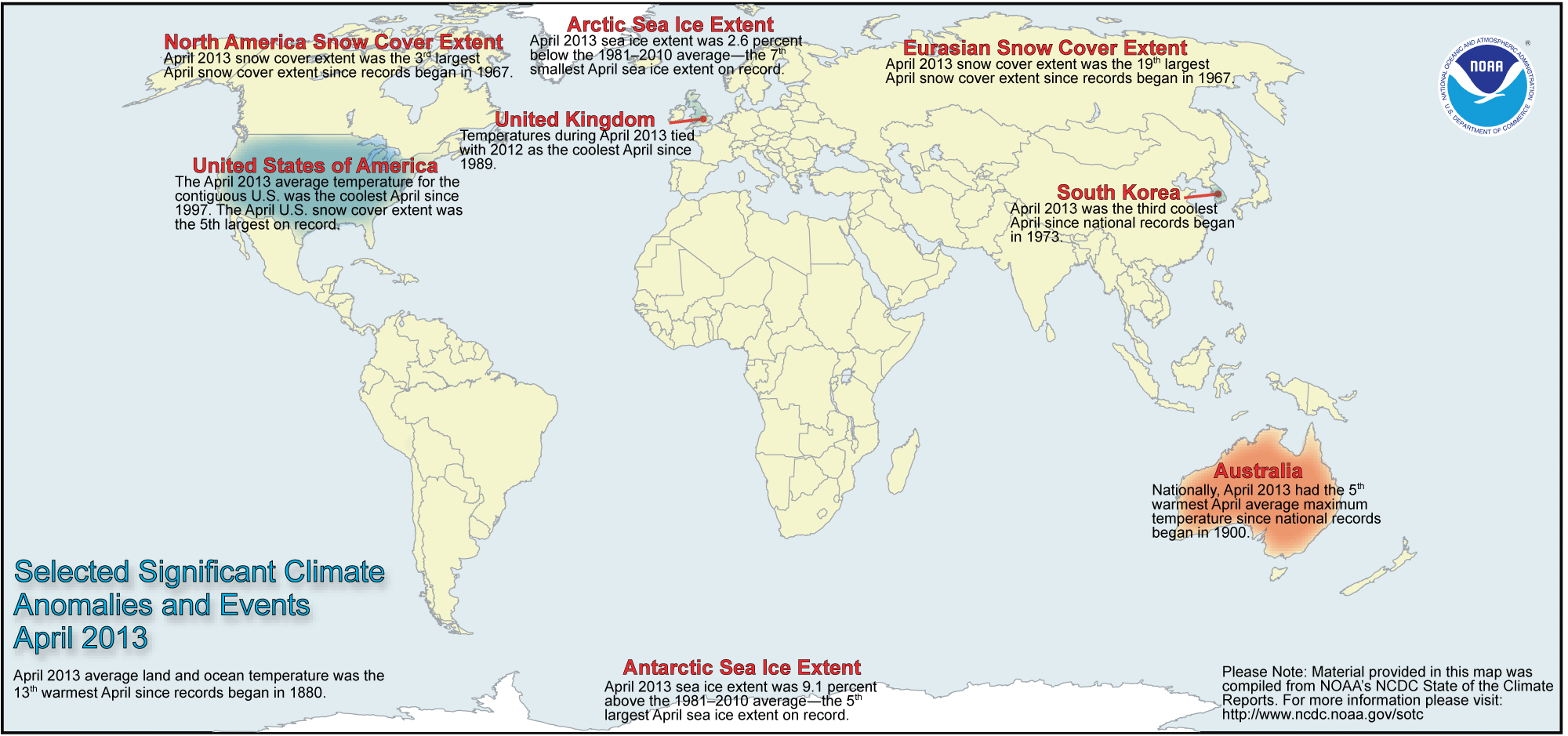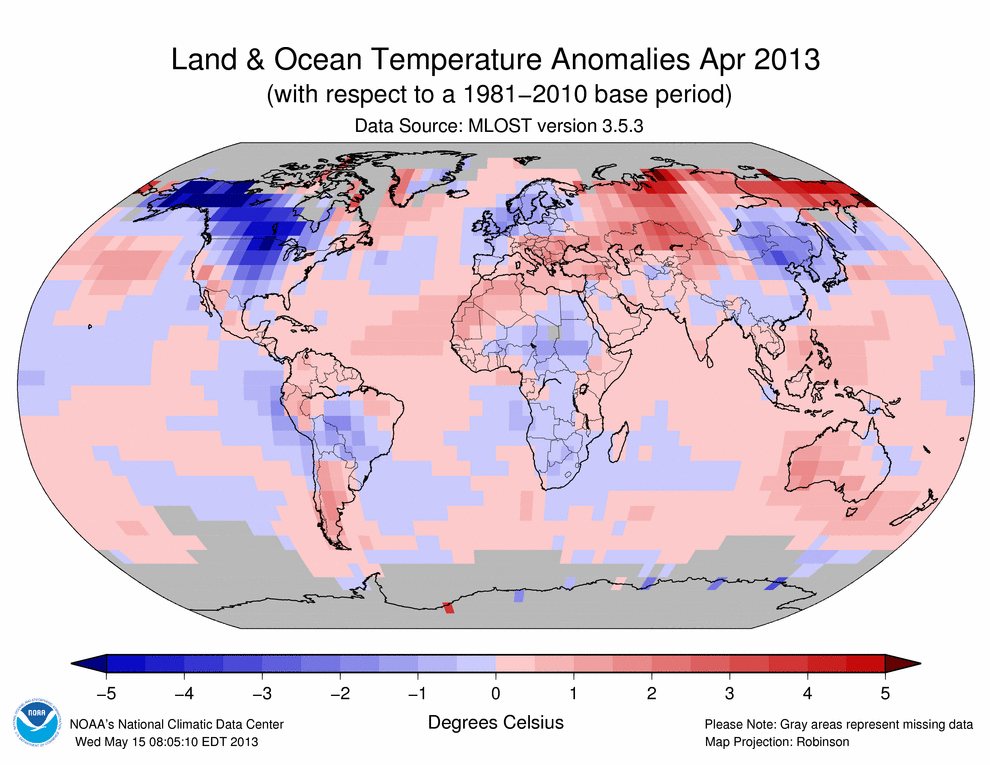Monthly Report Summary Information
The Monthly Report Summary Information is a synopsis of the collection of national and global summaries released each month.
Global Summary Information - April 2013
See Full Report
April 2013 global temperatures were 13th highest on record
Year-to-date eighth warmest period on record; North American snow cover extent third largest on record.
The globally-averaged temperature for April 2013 was the 13th warmest April since record keeping began in 1880. April 2013 also marks the 37th consecutive April and 338th consecutive month with a global temperature above the 20th century average.
Many areas of the world experienced higher-than-average monthly temperatures, including southern Europe, central Asia, the Russian Far East, southwestern Australia, southern Argentina, and western Greenland. Meanwhile, most of North America, northern and western Europe, northeastern Asia, central South America, and much of equatorial Africa were notably below average.
Global temperature highlights: April
- The combined average temperature over global land and ocean surfaces during April was the 13th highest on record for April, at 57.64°F (14.22°C) or 0.94°F (0.52°C) above the 20th century average. The margin of error associated with this temperature is ±0.14°F (0.08°C).
- April marked the 37th consecutive April and 338th consecutive month with a global temperature above the 20th century average. The last below-average April temperature was April 1976 and the last below-average temperature for any month was February 1985.
- The global land temperature was the 17th warmest April on record, at 1.28°F (0.71°C) above the 20th century average of 46.5°F (8.1°C). The margin of error is ±0.20°F (0.11°C).
- Some national highlights are included below:
- Australia had its fifth warmest April monthly maximum temperature on record since national records began in 1900, at 2.95°F (1.64°C) above the 1961–1990 average. At the state level, Western Australia reported its third highest monthly maximum temperature and fifth highest monthly minimum temperature.
- The average April temperature across the United Kingdom was 2.0°F (1.1°C) below the 1981–2010 average, tying with 2012 as the coolest April since 1989.
- The average April temperature across South Korea was 3.4°F (1.9°C) below the 1981–2010 average, marking the third coldest April since national records began in 1973. The average maximum temperature was also third lowest, while the average minimum temperature was second lowest on record.
- For the ocean, the April global sea surface temperature was 0.79°F (0.44°C), above the 20th century average of 60.9°F (16.0°C), tying with 2001 and 2009 as the seventh warmest for April on record. The margin of error is ±0.07°F (0.04°C).
- Neither El Niño nor La Niña conditions were present across the central and eastern equatorial Pacific Ocean during April, with sea surface temperatures below average in the far eastern equatorial Pacific. According to NOAA's Climate Prediction Center, neutral conditions continue to be favored over the next few months.
Precipitation highlights: April
- As is typical, monthly precipitation varied greatly across the globe during April. Record wetness was observed over part of the north central United States, eastern Burkina Faso, and part of eastern Russia. Record dryness was scattered across several locales around the globe, including northern Chile, central Colombia, southeastern Egypt, and part of northern Sudan.
- Following the declaration of drought conditions in March across much of New Zealand, more than double average April rainfall was recorded in the upper South Island and Tauranga. Motueka received 267 percent of its average April rainfall, with almost half of this occurring in a single day.
Polar ice highlights: April and Seasonal
- According to data from the Rutgers Global Snow Lab, the Northern Hemisphere snow cover extent for April was the ninth largest in the 47-year period of record and the largest since 1996. The April snow cover extent was 12.4 million square miles, 0.8 million square miles above the 1981–2010 average of 11.6 million square miles. Above-average snow cover was present for both Eurasia and North America, which had their 19th and 3rd largest April snow cover extents on record, respectively.
- According to data from the National Snow and Ice Data Center, the average April Arctic sea ice extent was 5.55 million square miles, approximately 150,000 square miles (2.6 percent) below the 1981–2010 average of 5.70 million square miles, resulting in the seventh smallest monthly April extent on record.
- Antarctic sea ice extent was 3.12 million square miles, 260,000 square miles (9.1 percent) above the 1981–2010 average of 2.86 million square miles. This marked the fifth largest April Antarctic sea ice extent on record.
Global temperature highlights: Year-to-date
- The first four months of 2013 (January–April) tied with 2009 as the eighth warmest such period on record, with a combined global land and ocean average surface temperature of 1.01°F (0.56°C) above the 20th century average of 54.8°F (12.6°C). The margin of error is ±0.18°F (0.10°C).
- The January–April worldwide land surface temperature was 1.71°F (0.95°C) above the 20th century average, making it the 10th warmest such period on record. The margin of error is ±0.38°F (0.21°C).
- The global ocean surface temperature for the year-to-date was 0.76°F (0.42°C) above average, making it the eighth warmest such period on record. The margin of error is ±0.09°F (0.05°C).
 NOAA's National Centers for Environmental Information
NOAA's National Centers for Environmental Information



